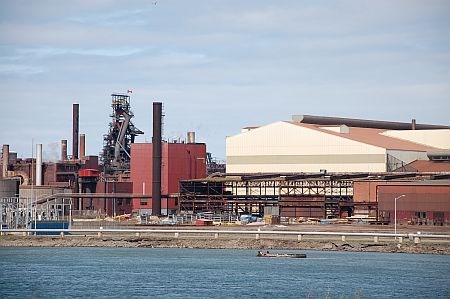The North American steel industry may be in the dumper but that doesn’t mean jobs aren’t available.
In Sault Ste. Marie, when jobs become available it doesn’t take long for word to circulate. Despite the steel plate maker’s boom-and-bust cycles, landing employment at the city’s largest private employer is still a prized opportunity.
The company is on a hiring blitz looking for both trades and labour in departments across the complex to replenish the ranks of the 3,500 unionized workforce.
Since starting their hiring campaign last fall, the company is looking to fill a full range of positions, including electrical and mechanical maintenance technicians, bricklayers, metallurgists, engineers, along with managers, supervisors and specialists in cokemaking, IT, accounting, and occupational health and safety.
When the economy crashed in the fall of 2008, so did Essar Algoma’s order book. It was tough sledding in the months that followed as the company engaged in temporary layoffs and proposed its unionized workers go down to four-day work weeks to cut labour costs.
Out of those measures came a retirement incentive program. Many took the company up on its offer. With an average employee age at 47, the attrition rate is up and stands only to increase in the coming years, opening up job opportunities at Essar in virtually all departments.
"We're seeing a large number of retirements," said Brenda Stenta, Essar Steel Algoma’s manager of corporate communications, with 180 retirements in 2009, up from 140 the previous year. Essar is concentrating, not so much on attracting new workers for entry-level positions, but on prospective employees with some experience under their belt.
Stenta said the steel industry’s historic hiring cycles come into play.
Many in Sault Ste. Marie remember the hiring freeze at the former Algoma Steel in the 1990s, indicative of the tough economic times the company and the entire industry experienced.
"There was a gap of a 10-year period when there was little hiring in the steel industry and we started hiring again in the early 2000s."
As people advanced internally in the organization, mid-level supervisory positions needed to be filled. Those positions are opening up again.
Currently there are 75 remaining vacancies, with half of those in the trades.
There’s a particularly strong need for experienced electrical maintenance technicians. Company personnel manager John DeLorenzi said the response to the job openings has been strong, as expected, mainly through word of mouth.
"All we have to do is tell one person in the community."
A September job fair for labourers drew 800 job hunters. From those interviews, Essar hired 70. Many are a combination of locals and ex-pats coming home to the Sault.
Since job openings were posted last fall on the company’s career web pages, in e-mail alerts, in daily newspapers and Internet job boards like Workopolis, Essar’s human resources staff have handled about 2,000 applications.
"We offer a pretty competitive wage and benefits package and there’s pretty stimulating career opportunities and lots of opportunity for growth," said Stenta.
"We're a progressive multi-national organization and we like to hire people from the Sault and the North."
Stenta expects to see Essar in a similar hiring mode for the next couple of years. She wouldn’t comment on what future job positions might be available until those jobs are officially posted. She cautioned this hiring binge shouldn’t be construed as any major employment or production expansion, as it is merely maintaining the current workforce level.
Though some departments have been "re-aligned" through organization restructuring and in some cases redefined, the majority of the vacancies are existing roles, she said.
"I wouldn’t take this as an indication of the strengthening of the order book," she said. "The market is still very soft and we’re not seeing any material increase in demand. The outlook for the balance of 2010 is still relatively weak."
Malay Mukherjee, the new CEO of the Mumbai-based Essar Group’s global steel operations, wants to expand capacity at their international steel operations, including boosting capacity at Essar Algoma (acquired in 2007) from 3.2-million tonnes to 4-million tonnes. Essar is also proceeding with construction of a steel mill on the iron range of northern Minnesota.
Stenta said for the Sault plant to meet that run rate in plate production, the company would have to make significant capital improvements.
According to multiple published reports, the Essar Group is keen on increasing operations in its overseas branch plants and is eager to boost its market share in the U.S. in steel plates.
www.algoma.com/careers




